Top Rankings
Duplin County Schools School District ranks among the top 20% of public school district in North Carolina for:
Category
Attribute
Community Size
Largest student body (number of students) (Top 1%)
For the 2025 school year, there are 7 public preschools serving 6,028 students in Duplin County Schools School District. This district's average pre testing ranking is 2/10, which is in the bottom 50% of public pre schools in North Carolina.
Public Preschools in Duplin County Schools School District have an average math proficiency score of 33% (versus the North Carolina public pre school average of 51%), and reading proficiency score of 32% (versus the 46% statewide average).
Minority enrollment is 72% of the student body (majority Hispanic), which is more than the North Carolina public preschool average of 59% (majority Black and Hispanic).
Overview
This School District
This State (NC)
# Schools
13 Schools
994 Schools
# Students
9,821 Students
464,055 Students
# Teachers
617 Teachers
33,275 Teachers
Student : Teacher Ratio
16:1
16:1
District Rank
Duplin County Schools School District, which is ranked within the bottom 50% of all 320 school districts in North Carolina (based off of combined math and reading proficiency testing data) for the 2021-2022 school year.
The school district's graduation rate of 85% has increased from 81% over five school years.
Overall District Rank
#258 out of 325 school districts
(Bottom 50%)
(Bottom 50%)
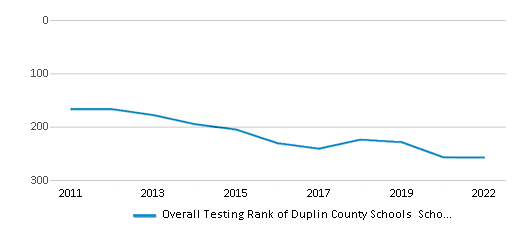
Math Test Scores (% Proficient)
36%
51%
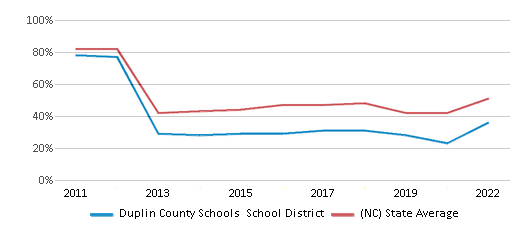
Reading/Language Arts Test Scores (% Proficient)
34%
50%
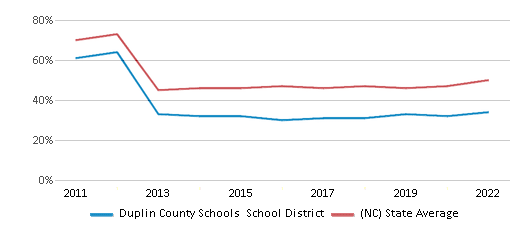
Science Test Scores (% Proficient)
49%
63%
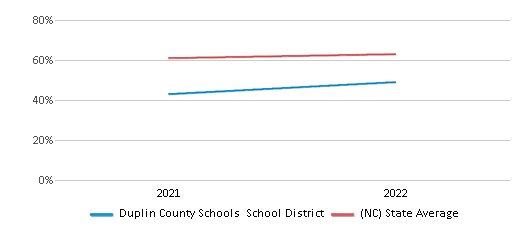
Graduation Rate
85%
86%

Students by Ethnicity:
Diversity Score
0.66
0.72
# American Indian Students
73 Students
6,572 Students
% American Indian Students
1%
1%
# Asian Students
25 Students
18,458 Students
% Asian Students
n/a
4%
# Hispanic Students
4,616 Students
105,943 Students
% Hispanic Students
47%
23%
# Black Students
2,029 Students
114,509 Students
% Black Students
21%
25%
# White Students
2,805 Students
189,147 Students
% White Students
28%
41%
# Hawaiian Students
6 Students
648 Students
% Hawaiian Students
n/a
n/a
# Two or more races Students
281 Students
28,778 Students
% of Two or more races Students
3%
6%
Students by Grade:
# Students in PK Grade:
296
23,104
# Students in K Grade:
700
72,144
# Students in 1st Grade:
711
74,289
# Students in 2nd Grade:
736
75,942
# Students in 3rd Grade:
682
68,925
# Students in 4th Grade:
719
69,686
# Students in 5th Grade:
753
66,668
# Students in 6th Grade:
731
5,021
# Students in 7th Grade:
750
3,684
# Students in 8th Grade:
732
3,629
# Students in 9th Grade:
899
214
# Students in 10th Grade:
738
194
# Students in 11th Grade:
748
187
# Students in 12th Grade:
626
368
# Ungraded Students:
-
-
District Revenue and Spending
The revenue/student of $10,465 in this school district is less than the state median of $11,187. The school district revenue/student has stayed relatively flat over four school years.
The school district's spending/student of $10,505 is less than the state median of $11,612. The school district spending/student has stayed relatively flat over four school years.
Total Revenue
$103 MM
$17,307 MM

Spending
$103 MM
$17,964 MM
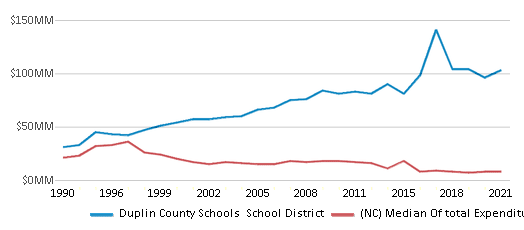
Revenue / Student
$10,465
$11,187
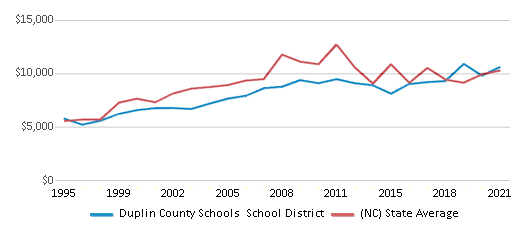
Spending / Student
$10,505
$11,612
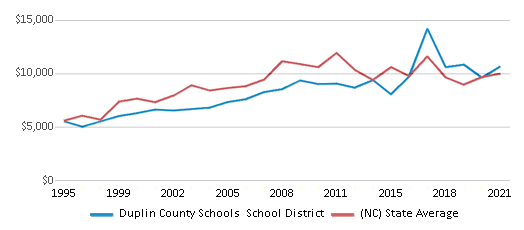
Best Duplin County Schools School District Public Preschools (2025)
School
(Math and Reading Proficiency)
(Math and Reading Proficiency)
Location
Grades
Students
Rank: #11.
Chinquapin Elementary School
(Math: 53% | Reading: 49%)
Rank:
Rank:
6/
Top 50%10
3894 Nc 50 South
Chinquapin, NC 28521
(910) 285-3476
Chinquapin, NC 28521
(910) 285-3476
Grades: PK-8
| 511 students
Rank: #22.
North Duplin Elementary School
(Math: 48% | Reading: 43%)
Rank:
Rank:
5/
Bottom 50%10
157 North Duplin School Road
Mount Olive, NC 28365
(919) 658-2931
Mount Olive, NC 28365
(919) 658-2931
Grades: PK-6
| 754 students
Rank: #33.
Beulaville Elementary School
(Math: 38% | Reading: 39%)
Rank:
Rank:
3/
Bottom 50%10
138 Lyman Road
Beulaville, NC 28518
(910) 298-3171
Beulaville, NC 28518
(910) 298-3171
Grades: PK-8
| 857 students
Rank: #44.
B F Grady Elementary School
(Math: 41% | Reading: 32%)
Rank:
Rank:
3/
Bottom 50%10
2627 N Nc 11 & 903
Albertson, NC 28508
(252) 568-3487
Albertson, NC 28508
(252) 568-3487
Grades: PK-8
| 877 students
Rank: #55.
Wallace Elementary School
(Math: 22% | Reading: 28%)
Rank:
Rank:
1/
Bottom 50%10
4266 Nc 11 S
Wallace, NC 28466
(910) 285-7183
Wallace, NC 28466
(910) 285-7183
Grades: PK-8
| 1,112 students
Rank: #66.
Warsaw Elementary School
(Math: 26% | Reading: 26%)
Rank:
Rank:
1/
Bottom 50%10
158 Lanefield Road
Warsaw, NC 28398
(910) 293-3121
Warsaw, NC 28398
(910) 293-3121
Grades: PK-8
| 803 students
Rank: #77.
Rose Hill-magnolia Elementary School
(Math: 24% | Reading: 23%)
Rank:
Rank:
1/
Bottom 50%10
1329 Brooks Quinn Road
Rose Hill, NC 28458
(910) 289-3667
Rose Hill, NC 28458
(910) 289-3667
Grades: PK-8
| 1,114 students
Recent Articles

Year-Round Or Traditional Schedule?
Which is more appropriate for your child? A year-round attendance schedule or traditional schedule? We look at the pros and cons.

Why You Should Encourage Your Child to Join a Sports Team
Participating in team sports has a great many benefits for children, there is no doubt. In this article you will learn what those benefits are.

White Students are Now the Minority in U.S. Public Schools
Increasing birth rates among immigrant families from Asia and Central and South America, combined with lower birth rates among white families, means that for the first time in history, public school students in the United States are majority-minority. This shift in demographics poses difficulties for schools as they work to accommodate children of varying language abilities and socio-economic backgrounds.





